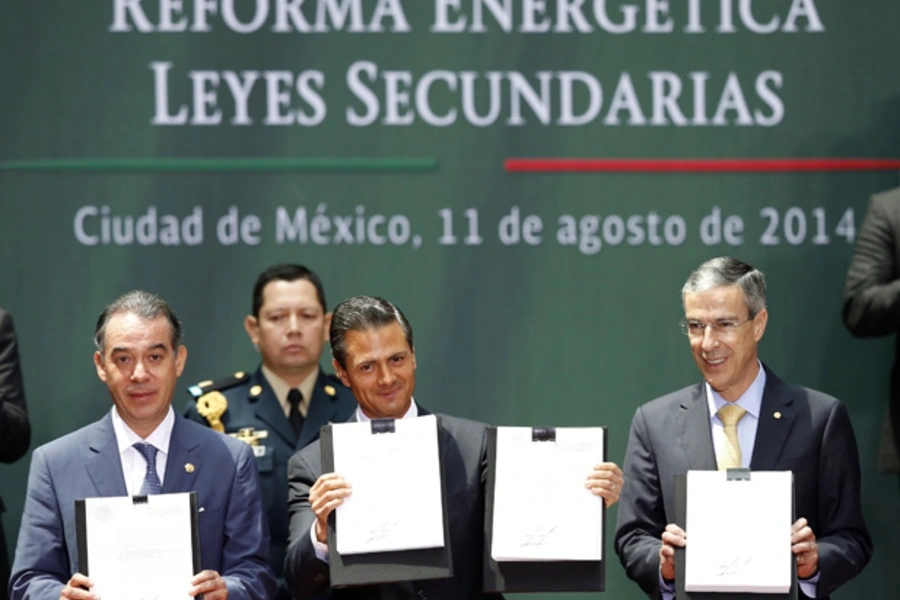Guest Post: Sustaining Mexico’s Energy Reform

This is a guest post by Greg Mendoza, an MA student at The Fletcher School, Tufts University. He previously was an intern in the Latin America Studies program at the Council on Foreign Relations.
Last year, Mexico passed a historic energy reform to end over seventy years of exclusive state control of the energy sector. Some analysts estimate drastic changes in the sector—with upwards of twenty billion dollars in foreign direct investment a year that could boost GDP 2 percent annually by 2025.
More on:
On August 11, President Peña Nieto signed into law the secondary legislation that dealt with issues ranging from the distribution of oil rents to the reorganization of the electricity sector. One important but less discussed aspect for the nation’s future will be the Mexican Fund for Stabilization and Development, designed to help the Ministry of Finance mitigate the negative effects of volatile energy prices.
Oil and commodity price fluctuations have buffeted Latin American economies for decades. Governments exacerbated the damage by maintaining procyclical fiscal regimes—increasing spending during booms and slashing budgets when prices fell. These policies are dangerous for states such as Mexico given that last year oil revenues accounted for sixty-six billion dollars, or one-third of the government’s annual budget.
The new Mexican Fund for Stabilization and Development will manage government energy revenues. Controlled by the Bank of Mexico, the country’s independent central bank, the fund will disburse an estimated sixty-three billion dollars to the federal budget (based on current receipts from Pemex). Assuming additional revenues, some of the monies will be saved while others will be allocated to programs such as the universal pension system and local development projects. A technical committee that consists of the Ministers of Finance and Energy, the Governor of the Central Bank, and four independent parties will recommend to congress the amounts given to each of these programs.
This structure contrasts with Mexico’s previous Oil Revenues Stabilization Fund. The previous fund could never save enough revenue to make a difference in downturns because of the balanced budget rule, which annually withdrew money from the old oil fund when there was a budget deficit. Under the new law, the technical committee limits transfers to the federal budget at 4.7 percent of GDP, and bigger outlays for economic emergencies require a two-thirds vote in the Mexican lower house.
In creating this new fund, Mexico hopes to replicate the success of other sovereign wealth funds. Chile’s Economic and Social Stabilization Fund is the best known in Latin America, credited with bailing the country out in the wake of the 2008 world financial crisis. With copper representing 20 percent of the country’s GDP, the fund saves surplus copper revenues during booms, and spends the reserves during economic downturns. The central bank manages the fund and is valued at almost $16 billion, a large sum for a country whose GDP was $277 billion in 2013. The government’s adherence to saving copper surpluses proved successful in 2008, when funds were quickly transferred to the federal budget to mitigate the effects of the Great Recession.
More on:
The success of Mexico’s new stabilization fund will depend on whether the new fiscal rules work. Saving money for a rainy day is not easy. Oil bounty could also push up the currency (the dreaded resource curse) hitting Mexico’s robust manufacturing sector, which represents three-fourths of its exports. However, the new stabilization fund addresses these concerns and removes the old restrictions on its savings, limits monetary transfers to the federal budget, and is managed by the independent central bank to minimize political interference. The new rules should insulate the economy from the negative effects of oil revenue variability and provide resources for future development. The fund’s success will be determined by the upcoming implementation, and although there are still challenges institutionalizing these reforms, the new laws are a positive first step in modernizing Mexico’s energy sector.
 Online Store
Online Store